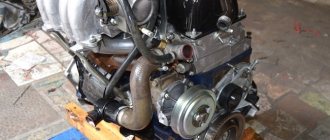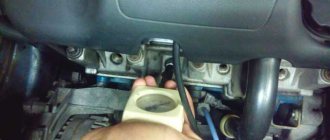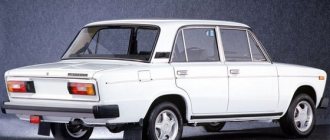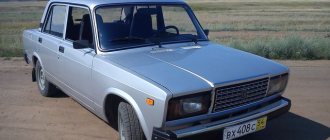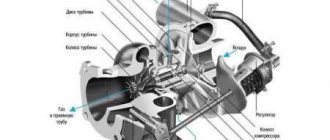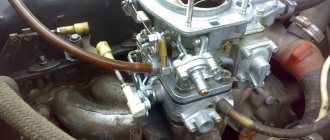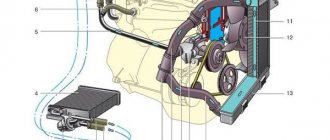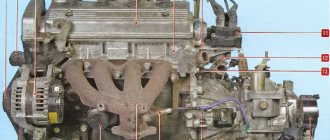Technical characteristics of the VAZ 2110,2111, 2112 engine
The engine was installed on such popular AvtoVAZ models as VAZ-2110, VAZ-2111 and VAZ-2112.
- Displacement - 1499 cc.
- Number of cylinders - 4 pcs.
- Number of valves - 16 pcs.
- Maximum power - 93 hp/5600 rpm.
- Maximum torque - 128 Nm/3700 rpm.
- Maximum engine power is 93 hp.
- Compression ratio – 10.5
- Gasoline octane number - 95
- Environmental standards - Euro 3
- Acceleration 0 - 100 km/h - 11.9 seconds.
- Combined cycle consumption - 7.2 L/100 km
- Engine life - 200 - 250 thousand km.
- Valves - oppression
Reliability, weaknesses, maintainability
Reliability
The reliability of the VAZ-2106 is beyond doubt. The engine is truly durable and reliable. Numerous positive reviews from car owners confirm this.
For example, Andrey from Stavropol states: “... according to the technician, this is the first repair on a VAZ 2106 engine in 27 years of operation with a mileage of 200 thousand km...”.
Dmitry from Smolensk completely agrees with him: “... 195 thousand cars have already been driven on it. I use semi-synthetics. No one climbed into the engine, and the technicians said that it was not necessary. The car is good in winter, when the guys in the yard couldn’t start their jeeps at -30 in -35, my VAZ 2106 started 1-2 times…”.
There are, of course, negative reviews. But in them, the authors themselves agree that on their part there was no proper care of the engine or there was aggressive operation of the machine.
The reliability of the internal combustion engine is stubbornly indicated by the fact that the engine's mileage has exceeded its service life. With timely and high-quality maintenance, the engine can last up to 400 thousand km without major repairs.
The concept of safety factor plays an important role in reliability. VAZ-2106 can be boosted to 200 hp. With.
It must be remembered that such tuning negates the durability of the unit. Mileage is reduced tenfold. And the costs of remaking the engine are also not cheap. For lovers of powerful engines, an engine swap would be the most suitable option.
Another indicator of the reliability of the unit is its modernization. Based on the VAZ-2106, several versions of this engine were created, which were used on various models of VAZ cars.
Weak spots
The VAZ-2106 has weaknesses inherent in all VAZ engines. It should be noted that many of them are provoked by the car owners themselves.
Maslozhor. Occurs when using cheap types of oil. The consequences of this phenomenon are quite serious, resulting in significant material costs. Malfunctions caused by increased oil consumption - sticking of rings, increased wear of the ShPG. The only solution is to overhaul the engine.
Overheat. Causes could be a faulty thermostat, water pump, or stuck cooling fan. The issue is resolved by replacing them.
Floating speed. This malfunction is mainly caused by clogged carburetor jets or fuel filter. Maintaining the power system and using clean fuel eliminates this problem.
Extraneous noise when the engine is running. Here the culprits in most cases are unadjusted valves. Depending on the mileage and “age” of the engine, knocking noises can be caused by worn camshaft cams or piston pins. In any case, to identify the cause of unauthorized noise, the engine requires careful diagnostics.
Vibration when the motor is running. It can occur due to wear or destruction of engine mounts, incorrectly set ignition, carbon deposits in the combustion chambers and for a number of other reasons. In this case, it is also impossible to do without diagnostics.
Timely detection and elimination of identified faults allows you to significantly reduce or completely eliminate their negative impact on the engine.
Technical characteristics of the VAZ 21114 and 11183 engine
The engine was installed on such popular AvtoVAZ models as Lada Kalina, VAZ 2108, 21083, 2109, 21093, 21099, 2113, 2114, 2115, 2110, 2111, 2112.
- Displacement - 1596 cc.
- Number of cylinders - 4 pcs.
- Number of valves - 8 pcs.
- Maximum power - 81 hp / 5200 rpm.
- Maximum torque - 125 Nm/3000 rpm.
- Maximum engine power - 81 hp.
- Compression ratio – 9.6
- Gasoline octane number - 92.95
- Environmental standards - Euro 2,3,4
- Acceleration 0 - 100 km/h - 12.9 seconds.
- Combined cycle consumption - 7.6 L/100 km
- Engine life - 150 - 250 thousand km.
- Valve - no bending
Conclusion
Therefore, to summarize and name the best VAZ engine, we give preference to the 21127 power unit, which in all respects is ahead of its competitors in this impromptu rating, but with one amendment, since its owners should be prepared for significant financial costs in the event of unexpected malfunctions . This top of the best is our subjective opinion and you may well either support it or disagree with our opinion. You can always present your arguments on this matter with reviews in the comments on the forum, share interesting photos and videos, and also offer your own options, which, in your opinion, are worthy of the title of the best VAZ engine.
Share with your friends:
Technical characteristics of the VAZ 21116 and 11186 engine
The engine was installed on such popular AvtoVAZ models as Lada Granta, Lada Kalina 2.
- Displacement - 1596 cc.
- Number of cylinders - 4 pcs.
- Number of valves - 8 pcs.
- Maximum power - 87 hp/5100 rpm.
- Maximum torque - 140 Nm/3800 rpm.
- Maximum engine power - 87 hp.
- Compression ratio – 10.5
- Gasoline octane number - 95
- Environmental standards - Euro 4
- Acceleration 0 - 100 km/h - 10.9 seconds.
- Combined cycle consumption - 7.2 L/100 km
- Engine life - 200 - 250 thousand km.
- Valve - no bending
Catalog of Russian engines for passenger cars: 2019
Do you think there are many modern Russian-made domestic engines for passenger cars and light commercial vehicles currently on sale in our market? No, really, how much? Do you think the auto industry is practically extinct and is living out its life on the scraps of past decades? Or have our engineers not made the appropriate conclusions and are not developing previously released power unit models? Do you think so?
Think again, because in fact, the variety that a buyer may encounter when choosing certain domestic car models is truly amazing. And the point here is not only and not so much in the volume of engines or the types of fuel on which they operate. It turns out that if you delve a little into the jungle of technical data of these engines, domestic engines undergo so many qualitative changes and improvements during their life cycle that the initially appeared version would be hard to call identical to what is coming off assembly lines today and leaving the gates of factories and production facilities. . So many improvements and improvements have been made. Real improvements. Effective and high quality. Yes, we understand that direct users certainly have some complaints. But we repeat, what happened before and what they do now are radically different. Earth and sky!
Let's look at the main variations of power units that any of us can afford to purchase. From AvtoVAZ engines to the legendary ZMZ, which can be found in the engine compartment, from the shiny Lada Vesta Sport to the UAZ-452 “Loaf”, a worker of forests and fields. These motors are still running. And they are no worse than their foreign counterparts, and perhaps in some ways they bypass them due to their simple design.
In general, welcome to the catalog of the most common types and types of motors. Begin!
PS Although the catalog was compiled with passenger cars and light commercial vehicles in mind, it also contains examples of powertrains from trucks. The fact is that in some factories it has historically happened that the threads of the assembly lines go both for small vans like Sobol, various modifications of UAZ SUVs, and for cargo Lawns and PAZ buses.
Technical characteristics of the VAZ 21214 engine
The engine was installed on such popular AvtoVAZ models as Chevrolet Niva and LADA 4×4.
- Working volume - 1690 cc.
- Number of cylinders - 4 pcs.
- Number of valves - 8 pcs.
- Maximum power - 81 hp/5200 rpm.
- Maximum torque - 125 Nm/3000 rpm.
- Maximum engine power - 81 hp.
- Compression ratio – 9.4
- Octane number of gasoline - 92.95
- Environmental standards - Euro 4
- Acceleration 0 - 100 km/h - 12.9 seconds.
- Combined cycle consumption - 10.5 L/100 km
- Engine life - 100 - 150 thousand km.
- Valve - no bending
Service
Maintenance of the Lada “Classic” engine is often carried out at home. This is due to the simplicity of the design. Maintenance is quite simple for the Lada Classic engine. An oil change is carried out every 10,000 km.
It includes changing the lubricant and oil filter element. The amount of oil required for replacement is 4-4.5 liters. When choosing an oil, everything is simple; the manufacturer recommends using a mineral lubricant.
But, as practice has shown, semi-synthetic motor oil is best suited.
Technical characteristics of the VAZ 21124 engine
The engine was installed on such popular AvtoVAZ models as VAZ-2110, VAZ-2111 and VAZ-2112.
- Displacement - 1599 cc.
- Number of cylinders - 4 pcs.
- Number of valves - 16 pcs.
- Maximum power - 89 hp/5000 rpm.
- Maximum torque - 131 Nm/3700 rpm.
- Maximum engine power is 89 hp.
- Compression ratio – 10.3
- Gasoline octane number - 95
- Environmental standards - Euro 4
- Acceleration 0 - 100 km/h - 10.7 seconds.
- Combined cycle consumption - 7.5 L/100 km
- Engine life - 200 - 250 thousand km.
- Valve - no bending
Interesting on the site: VAZ 2107 injector
Main manufacturers of internal combustion engines in Russia
In total, there are about 30 engine factories in the Russian Federation. But only four of them are engaged in large-scale production of engines for civilian use:
- UMZ is an Ulyanovsk plant specializing in the production of diesel and gasoline engines of EURO-4 and EURO-5 standards. Its products are used on cars, jeeps and small utility vehicles;
- ZMZ is a Zavolzhsky plant that produces in-line four-cylinder power units with a gasoline-type fuel system. Main target audience: passenger cars;
- AvtoVAZ is a Volzhsky plant specializing in the production of passenger cars, SUVs and their components, including engines. The manufacturer has a whole line of gasoline internal combustion engines with carburetor and injection power systems;
- GAZ is a Nizhny Novgorod plant that produces engines for cars, trucks and passenger cars. The samples he proposed are of only two types: in-line 4 and 6 cylinder.
Other engine factories, such as KAMAZ, TMZ, etc., produce power units exclusively for specialized equipment. Their products are widely popular abroad. But in terms of the reach of the target audience, they can be called highly specialized.
Technical characteristics of the VAZ 21126 engine
The engine was installed on such popular AvtoVAZ models as Priora, Granta, Kalina 2.
- Displacement - 1597 cc.
- Number of cylinders - 4 pcs.
- Number of valves - 16 pcs.
- Maximum power - 98 hp/5600 rpm.
- Maximum torque - 145 Nm/4000 rpm.
- Maximum engine power is 98 hp.
- Compression ratio – 11
- Gasoline octane number - 95
- Environmental standards - Euro 4
- Acceleration 0 - 100 km/h - 10.1 seconds.
- Combined cycle consumption - 7.2 L/100 km
- Engine life - 200 - 300 thousand km.
- Valves - oppression
"UAZ", "GAZ". JSC "Zavolzhsky Motor Plant" (ZMZ)
Zavolzhsky Motor Plant, focused on the production of a variety of automobile engines, was founded as a separate enterprise in 1958. However, the history of the plant began two years earlier. The enterprise was founded as a branch of the Gorky Automobile Plant. Then it began to produce spare parts and aluminum engine elements for GAZ cars.
A distinctive feature of the enterprise is a wide range of power units for a variety of cars. At different times, it produced both engines for passenger cars, such as the Volga and UAZ brands, and for trucks like the GAZ-3308 Sadko.
The company launched the production of 4- and 8-cylinder engines, which also sets the engine plant apart from other domestic enterprises.
Over more than 60 years of history, about 15 million engines have been produced.
Despite the diversity of the engine line https://www.zmz.ru/Produktciya/Dvigateli_ZMZ, the main power units can be divided into five basic variations: ZMZ-409.10 , ZMZ-514.10 , ZMZ-523.10 , ZMZ-5245.10 , ZMZ-405.10 , ZMZ -406.10 , ZMZ-5143.10 , ZMZ-523.10 , ZMZ-511.10 and ZMZ-513.10 .
Technical characteristics of the VAZ 21128 engine
The engine was installed on such popular AvtoVAZ models as VAZ 21104, Lada 2112 Coupe 1.8, Lada Priora 1.8
- Working volume - 1796 cc.
- Number of cylinders - 4 pcs.
- Number of valves - 16 pcs.
- Maximum power - 98 hp. /5200 rpm
- Maximum torque - 162 Nm/3200 rpm.
- Maximum engine power is 98 hp.
- Compression ratio – 10.5
- Gasoline octane number - 95
- Environmental standards - Euro 4
- Acceleration 0 - 100 km/h - 9.8 seconds.
- Combined cycle consumption - 7.5 L/100 km
- Engine life - 100 - 150 thousand km.
- Valves - oppression
There is also an interesting article on the site about the boxer engine
So which one is better?
Having familiarized ourselves with the main characteristics of our contenders, we can now safely sum up the overall results and name the winner. If you approach the question from a rational point of view, the answer to the question: “which VAZ engine is the best?” seems more than obvious - the last in the line, that is, the newest and most modified, and indeed, the VAZ 21127 engine, after all its modifications, looks like a clear favorite for the title of best, because for all its shortcomings, these are the same problems as in 21126 In case of timing belt failure and expensive maintenance, it offers very cool performance, especially for those who like to ride with the breeze. VAZ 21126 and 21127 are like brothers, however, the “twenty-seventh” is younger, but stronger, and the “twenty-sixth” is older and more confident, so to speak, that is, more significant in terms of the audience reached. Therefore, we will not even try to compare these two engines with each other, but will combine their capabilities against a common competitor - the VAZ 21116. Here we will formulate the question somewhat differently: “which engine is better, eight valve or sixteen valve?”
As an answer and, accordingly, to determine the winner, we present the following information: the main power records demonstrated by VAZ engines were achieved precisely with the help of units with 16 valves, and most importantly, when choosing a car with a 16-valve power unit, positive the owner receives more aspects than negative ones. An increase in the used volume of the fuel-air mixture, which enters the cylinders, also affects the increase in power, which is confirmed by the technical descriptions of each of the engines. In addition, changing the shape of the combustion chamber in the 16-valve engine allows it to show higher knock resistance, which is very important given the quality of the fuel that is sold at gas stations. It should also be said that in engines with 16 valves the cooling system works better, which helps to increase the reliability of the power unit. What the 8-valve unit benefits from is cheaper maintenance and, in fact, availability, since it costs less than its competitors. At one time, 8-valve power units were optimal for operation in our conditions, however, progress has made positive adjustments, allowing the engines to be modernized.
Video instructions on how to make a good VAZ engine
Technical characteristics of the Lada Granta Sport 120 hp engine.
- Displacement - 1597 cc.
- Number of cylinders - 4 pcs.
- Number of valves - 16 pcs.
- Maximum power - 118 hp/5900 rpm.
- Maximum torque - 154 Nm/4740 rpm.
- Maximum engine power is 118 hp.
- Compression ratio – 11
- Gasoline octane number - 95
- Environmental standards - Euro 4
- Acceleration 0 - 100 km/h - 9.3 seconds.
- Combined cycle consumption - 7.8 L/100 km
- Engine life - 250 - 300 thousand km.
- Valves - oppression
Load distribution
From the above it follows that the fatigue of the VAZ-2101 body directly affects the state of the control points for fixing units and components, and is also manifested in the correct geometry of its front, rear and side openings.
When moving (in dynamics), the distribution of loads on the frame occurs as follows:
- From the front suspension parts, vibration and mechanical moments are transformed to the cross member with subsequent transfer to the sub-engine frame part.
- Next, the force is transferred to the surface of the mudguards and the front shield, which are classified as load-bearing body elements.
- In the rear, a similar picture occurs in a more simplified form. There are no motor mounts involved here; the transition goes straight from the suspension to the car frame.
Technical characteristics of the VAZ 21129 engine
The engine is installed on such popular AvtoVAZ models as the VAZ 2180
- Displacement - 1599 cc.
- Number of cylinders - 4 pcs.
- Number of valves - 16 pcs.
- Maximum power - 106 hp. /4800 rpm
- Maximum torque - 148 Nm/4000 rpm.
- Maximum engine power - 106 hp.
- Compression ratio – 11
- Gasoline octane number - 95
- Environmental standards - Euro 4
- Acceleration 0 - 100 km/h - 9.6 seconds.
- Combined cycle consumption - 7.2 L/100 km
- Engine life is 250 thousand km.
- Valves - oppression
Design features
Regardless of how much the VAZ-2101 weighs, the car body experiences not only static stress from the equipment installed on it, but is also forced to resist its effects under dynamic load. This property of the box is called torsional rigidity. On the car in question, this figure is approximately 7300 Nm/deg.
This technical parameter is significantly influenced by the condition of the bottom, roof, and thresholds. This is due to the fact that these elements are interconnected by the front panel. In addition, the strength characteristics and geometry of the body depend on the integrity of the door pillars, window panels and luggage compartment cross member. You can check the correct symmetry and general condition of the machine yourself. To do this, take the actual dimensions of the frame and compare them with the parameters specified in the car repair manual.
Material of manufacture
With this configuration of the body and suspension, the frame material plays a significant role in the safety and stability of the car. It is logical that strengthening the weak points of the body will make the vehicle stiffer and more stable on the road. But then the mass of the car will be critical, which will make it clumsy and very heavy.
When strengthening the frame, the weight of the “penny” and the load on all structural elements increases. That is why design engineers are trying to select the rational thickness of materials, taking into account the ratio of their dimensions and cross-section. The result is a fairly durable and not too heavy body.
To reduce weight and save on costs, elements that do not bear the load are made of thinner metal. The main parts have a thickness of about one millimeter, which corresponds to similar indicators for other cars of similar class.
Additional processing measures
It is worth noting that with dimensions of 4.07/1.61/1.44 meters, the car in question has a fairly acceptable weight. The strength and integrity of the body is affected not only by how much a “penny” weighs and how thick the metal is, but also by the quality of factory and independent anti-corrosion treatment.
According to the rules, after welding procedures, before painting, the car body must undergo phosphatization. During this treatment, the entire surface of the frame was covered with a special phosphate film that is resistant to chemical attack. In addition, the effect was secured by applying a layer of primer, which was sprayed using electrophoresis. This allowed the primer to provide even coverage in the most difficult to reach areas. The bottom of the vehicle was treated with a special reinforced mastic, which reliably protects the bottom from the effects of an aggressive environment.
